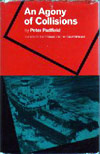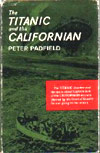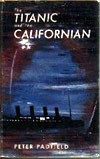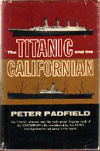|
| To Search This Site Enter Key Words Into Text Field On The Right and Hit The Search Button |
|
|
Peter Padfield. For more information, see the author's website.
 |
Padfield, Peter. An Agony of Collisions. 1st printing. Lon: Hodder & Stoughton. 1966. hardcover. isbn: none. scarcity: fairly common.
The primary focus of this book is the author’s assertion that collisions between ships were, as often as not, caused by the very regulations that were supposed to prevent them. The text is broken into two sections, pre-radar collisions, and post-radar ones.
Radar, as opposed to making the sea lanes safer, had actually made them more dangerous (at least in the years between when radar came into common use and the 1960s when this book was written). Not only did inadequate training in the use of radar give commanders a false sense of security, allowing them to go faster in dangerous weather conditions than they would have otherwise, there was also the incredible reality of so-called radar-assisted collisions! Andrea Doria-Stockholm being the most famous example.
Padfield will be better known to readers of the Titanic disaster as the first person to publish a defense of Captain Lord of the Californian. Agony does not contain a lot of Titanic content, although the disaster is mentioned briefly in the pre-radar half of the book. Still, there is enough relevant material to be of interest.
For one, there is Alan Villiers wonderful account of William Murdoch’s cool handling of an emergency several years before the Titanic disaster. There is also an entire chapter on the Olympic-Hawke collision. This famous event is covered in much more detail than generally found in other books. Padfield’s conclusion? That White Star was rooked by the pro-Admiralty court system.
What makes this book particularly interesting, is that the author often covers both the collision and the resulting inquiry. Besides Olympic-Hawke, other infamous collisions covered include Andrea Doria-Stockholm, as well as lesser known tragedies like the Princess Alice-Bywell Castle, and the Crystal Jewel-British Aviator collisions. Unless you are well read in shipwrecks, the latter two will probably not ring a bell, but the first was a tragic pre-radar disaster, the second being another example of a radar-assisted collision.
The author concludes the book by discussing some well known recommendations that had been offered to change the rules of the road, most of which were found by the merchant marine to be inadequate. He finishes with his own recommendations about how the rules should be altered.
|
 |
Winner of the Titanic Book of the Year Award for 1965.
Padfield, Peter. The Titanic and the Californian. 1st printing. Lon: Hodder & Stoughton. 1965. . isbn: none. scarcity: fairly common.
Padfield was the first to publish a book on this incredibly contentious subject. Was there a ship within close proximity to the sinking Titanic, a ship that could have rescued everyone if only it had responded. And if there was such a ship, was it the Californian? Both the American and British inquiries believed it was and damned her captain, Stanley Lord for not acting. The author believes that Lord was innocent of the charges of negligence. His book sets out the basic arguments explaining why he felt Californian’s captain was unfairly condemned.
For years the debate has raged on. According to Captain Lord, his position that fateful night was almost 20 miles away from Titanic, too far for him to have reached the wreck in time to save anyone but the survivors in the lifeboats. According to the American and British inquiries and most knowledgeable sources then and since, the Californian was less than 10 miles away.
The discovery of the location of the Titanic wreck in 1985 supports Lord’s claims of a separation between the two ships of closer to 20 miles, rather than 10. But many doubts and inconsistencies remain. Still, if you are interested in this subject, Padfield’s book is required reading in understanding the background of the debate.
|
 |
Padfield, Peter. The Titanic and the Californian. reprint. Lon: Quality Book Club. 1965. hardcover. isbn: none. scarcity: fairly common. |
 |
Padfield, Peter. The Titanic and the Californian. 1st American printing. NY: John Day. 1966. hardcover. isbn: none. scarcity: fairly common.
This first American edition was published about a year after the original British edition.
|
|
|
|
|